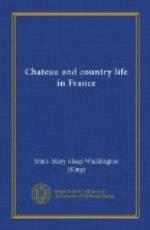After luncheon we went over to Soissons in the auto—the most enchanting drive through the forest of Villers-Cotterets—the poplar trees a line of gold and all the others taking the most lovely colours of red and brown. Soissons is a fine old cathedral town with broad squares, planted with stiff trees like all the provincial towns in France; many large old-fashioned hotels, entre cour et jardin, and a number of convents and abbeys, now turned into schools, barracks, government offices of all kinds, but the fine proportions and beautiful lines are always there.
The city has seen many changes since its first notoriety as the capital of the France of Clovis, and one feels how much has happened in the quiet deserted streets of the old town, where almost every corner is picturesque. The fine ruins of St. Jean des Vignes faced us as we drove along the broad boulevard. A facade and two beautiful towers with a cloister is all that remains of a fine old abbey begun in 1076. It is now an arsenal. One can not always get in, but the porter made no difficulty for us, and we wandered about in the court-yard and cloister. The towers looked beautifully grey and soft against the bright blue sky, and the view over Soissons, with all its churches and old houses, was charming. It seems that Thomas a Becket, Archbishop of Canterbury, lived at the Abbey when he was exiled from England and had taken refuge in France.
We wanted to go to the service in the Cathedral, but thought we would go first to the patissier (an excellent one, well known in all the neighbourhood) famous for a very good bonbon made of coffee and called “Tors de Soissons.” The little place was full—every schoolboy in Soissons was there eating cakes and bonbons. There was a notice up in the shop, “Lipton Tea,” and we immediately asked for some. The woman made a place for us, with difficulty, on a corner of a table and gave us very good English tea, toast and cakes. I complimented the patronne on her tea and she said so many automobiles with foreigners—English principally—passed through Soissons in the summer—all asking for tea—that she thought she must try to get some. One of the ladies told her where to get Lipton Tea and how much to pay for it. She has found it a very good speculation.
We walked to the Cathedral through a grand old Square planted with fine trees, that had once been a part of the garden of the Eveche. As it was getting dark, we could not see the outside very well. A gigantic mass of towers and little steeples loomed up through the twilight, but the inside was very striking—crowded with people, lights, banners, flowers everywhere—five or six priests were officiating and the Bishop in full dress, with his gold mitre on his head, was seated on his red velvet throne under the big crucifix. The congregation (there were a good many men) was following the service very devoutly, but there were a great many people walking about and stopping at




